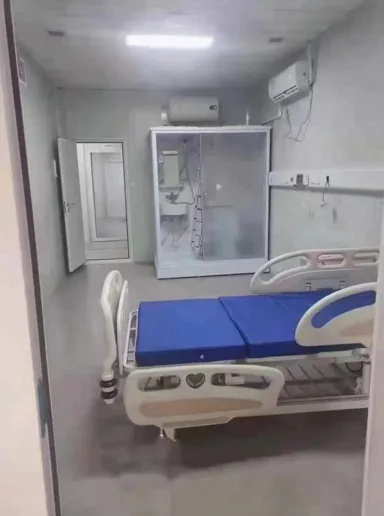
I. Project Overview
Project Name: Flat-Pack Container Emergency Hospital Construction Project
Application Scenario: Emergency quarantine hospitals for pandemic control/Expansion of permanent medical functional areas
Core Product: Flat-pack container houses (highly prefabricated)
Key Features:
Emergency response: Completion from decision to delivery in as little as 72 hours
Standardized design: Complies with GB50849-2014 “Code for Construction of Infectious Disease Hospitals”
Dual application: Suitable for both temporary emergency needs and permanent medical building use
II. Main Challenges
Extreme timeline pressure:
Required construction of 500-bed quarantine hospitals within 96 hours during pandemic outbreaks
Specialized medical functional requirements:
Implementation of “Three Zones and Two Passages” (clean zone/semi-contaminated zone/contaminated zone; medical staff passage/patient passage)
Stable maintenance of negative pressure room air pressure difference ≥5Pa
High system integration complexity:
Integration of medical gas pipelines, intelligent management systems, and sewage treatment devices
Adaptability to extreme environments:
Normal operation required in temperatures ranging from -30℃ (northeastern China) to 40℃ (southern China)
III. Solutions
Modular combination design:
Medical units: 6m×3m standard modules configured for:
Negative pressure ward units (4 beds/unit)
Medical staff office units (including buffer rooms/changing rooms)
CT container units (3-module combination)
Passage system: Double-layer corridor containers (lower level for patients/upper level for medical staff)
Rapid deployment technology:
95% factory prefabrication: Including wall panel openings and pre-embedded pipelines
On-site assembly: 6-person team can assemble 1 ward unit per hour
Integrated hoisting: Supports up to 3-story container stacking
Medical-specific integration:
Wall-embedded medical service columns (oxygen/negative suction/power interfaces)
Roof-integrated negative pressure exhaust systems (HEPA filtration efficiency 99.97%)
Full-floor waterproofing membrane (medical-grade silicone sealing at joints)
Intelligent management system:
IoT monitoring system: Real-time tracking of ward temperature/humidity/air pressure
One-click disinfection: Remote timed activation of UV lamps
Patient call system: Bedside terminals directly connected to nursing stations
IV. Product Details
Main structure:
Frame: Q355B high-strength steel (seismic resistance Grade 8)
Wall panels: 100mm rock wool sandwich panels (Class A fire rating, sound insulation Rw=42dB)
Medical-specific configurations:
Doors/windows: Airtight medical doors + double-layer antibacterial glass windows
Flooring: 2mm PVC medical sheeting (antibacterial and corrosion-resistant)
Interfaces: Pre-embedded medical gas pipelines/weak current systems/water supply and drainage pipes
Environmental control systems:
Negative pressure system: 300m³/h air volume (per ward)
HVAC system: Medical-grade split AC + fresh air exchange
Disinfection system: Hydrogen peroxide spray disinfection devices
V. Project Achievements
Construction speed:
Wuhan Leishenshan Hospital: 1,000-bed hospital built in 10 days
Hong Kong Emergency Hospital: 500 isolation wards hoisted in 5 days
Medical effectiveness:
Negative pressure stability: Air pressure fluctuation < ±1Pa
Air cleanliness: Meets WHO standards for medical spaces
Sustainability:
Reuse rate: 90% materials can be disassembled and reused
Adaptability: Rapid conversion to vaccination centers/fever clinics
Industry Value Demonstration
Flat-pack container houses have achieved through highly industrialized production and innovative modular design:
Setting benchmarks for “China construction speed” (3-day hospital construction)
Solving the “dual-use for peace and pandemic” challenge (seamless conversion between temporary and permanent functions)
Establishing new standards for “smart medical infrastructure” (integration of 5G/IoT systems)
Practicing “green development” principles (>90% material recycling, 80% construction waste reduction)
This model has been implemented in 28 provinces across China, accumulating over 5 million square meters of emergency medical facilities, serving as a exemplary Chinese solution for global pandemic response.